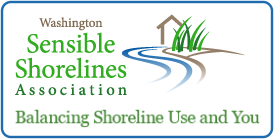Non Conforming Uses
Truth about ‘non-conforming’ shoreline structures

This non-conforming structure on Whidbey Island in Island County was built before the state Shoreline Management Act was passed by voter referendum in 1972. Now a bed and breakfast, planned development at the site will need to be reviewed and approved by the county and Ecology to ensure there are no further adverse effects to the shoreline environment.
Contrary to what some would have you believe, the Department of Ecology is not out to strip away your private property rights using the state Shoreline Management Act, passed by referendum vote in 1972.
Across the state, Web sites, flyers, meetings, and seminars are being created, distributed, and held to describe the work Ecology is doing with local governments to help modernize local and state shoreline regulations.
Don’t be misled. These activities are being done independently of my department and most local governments.
Claims are being made that Ecology and local governments want to intrude on the use and economic value of private property, stifle the economic vitality of our communities, and infringe on your constitutional rights — all in the name of effective environmental conservation.
Many of these concerns are being voiced in a way to create alarm rather than seeking to understand the facts of the situation. And, unfortunately, some pretty important facts are being inaccurately portrayed.
“Grandfathering” non-conforming shoreline development
One of the issues being mischaracterized to create alarm is about “non-conforming” or “grandfathered” development in our shoreline areas.
So what is “non-conforming use or development” under the state Shoreline Management Act?
Simply put, these are uses or developments in regulated shoreline areas that have been lawfully constructed or established before a town, city or county adopted or amended their current shoreline plans and regulations.
These integrated plans, rules and permitting requirements are also called “shoreline master programs.” And most local jurisdictions are either in the process or soon will be working to modernize their shoreline master programs.
Unfortunately, a rumor is getting legs based on a single sentence plucked out of context from one guidance presentation Ecology gave to city and county planners in October 2007. The allegation is that somehow my agency wants to eliminate all non-conforming shoreline structures and uses. The result, they say, would be an illegal taking of private property without due process of law.
Pretty scary stuff but it’s simply not true.
Working with local governments to protect property & the environment
Non-conforming structures in our shoreline areas can be maintained and repaired. In fact in some cases, these structures can even be enlarged or expanded. There is no requirement for a homeowner to change anything about their property when new shoreline regulations go into effect. The new standards only apply if a property owner changes certain key aspects such as the size or location of their home or in very limited cases where a property is abandoned or purposely destroyed.
Ecology administers the state Shoreline Management Act in partnership with more than 260 town, city and county governments across the state. I can say without reservation that we all recognize and provide for non-conforming and grandfathered uses. This has been the practice since passage of the Act and is clearly spelled out in state regulations.
Our policy on non-conforming structures and uses addresses a host of vital shoreline concerns including protecting views, shielding structures from erosion, and ensuring critical habitat buffers while treating owners of existing and new structures fairly and equitably.
The state Shoreline Management Act encourages local governments to tailor their standards for non-conforming uses to meet the unique needs of their community. As long as environmental resources in shoreline areas are protected, local standards can be flexible and address distinctive, specific needs.
Ecology’s goal is balancing habitat protection while allowing residents to maintain and improve their homes in our shoreline areas. Furthermore, Ecology is directed by the Shoreline Management Act to ensure thatunconstitutional “takings” of private property don’t occur as a result of shoreline regulation. Whether it’s Ecology or a local government, I can assure you that there are public sector attorneys reviewing our decisions to make sure they are lawful.
Whatcom County, for example, was the first county to modernize their shoreline master program using Ecology’s new 2003 shoreline guidelines. Ecology and the county collaborated on non-conforming standards.
Ecology and the Growth Management Act
I also want clear up any confusion about Ecology’s role regarding critical areas ordinances. Local governments are responsible for adopting these ordinances to protect five types of environmentally-sensitive areas, including wetlands and fish and wildlife habitat, located outside of our shoreline areas. This process is currently under way in San Juan County.
Critical areas ordinances are required under the state Growth Management Act (GMA). Ecology does not administer the GMA.
Ecology does, however, have expertise in managing and protecting wetlands. To help local governments meet GMA requirements without reinventing the wheel, Ecology got a federal grant in 2002 and spent three years crafting wetlands guidance.
So far, over 100 local jurisdictions have based their wetland ordinances on our guidance. Many local governments have successfully adopted language about non-conforming uses that tailors their critical areas regulations to local conditions.
While Ecology plays an important role in commenting on critical areas ordinances for wetlands, local governments are not required to adopt our guidance documents. Under GMA they do have to include best available science when adopting critical areas ordinances.
Existing non-conforming development is an important issue as Ecology and local governments work together to update our locally-tailored shoreline master programs. However, we need to make sure that what is being presented is factual. To do anything less is an enormous disservice to us all.
For more information, including a “Frequently Asked Questions” regarding Ecology’s role in shoreline management and helping local governments modernize their shoreline master programs, please visit our Web site at:http://www.ecy.wa.gov/programs/sea/sma/index.html.
